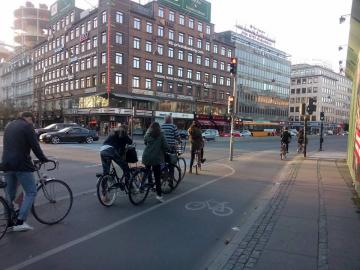
At the beginning of February, Sustrans organised an event called 'Bringing Copenhagen to Birmingham', inviting speakers to talk about the importance of promoting cycling and the best ways in which to do that. Sustrans has been commissioned to produce 'Bike Life' reports on 7 cities in the UK, including Birmingham, based on the Copenhagen Bicycle Account that keeps track of the development of cycling there (see the 2014 report here). At the event we heard from: Ewan Hamnett, chair of Birmingham Wellbeing Board; Anne Shaw, Acting Assistant Director for Transport and Connectivity, BCC; Karen Creavin, Head of Wellbeing Services, BCC; Phil Jones, of the transport planning consultancy, Phil Jones Associates; and Will Haynes, Head of Built Environment for Sustrans. Notable by their absence were Birmingham's politicians, with only Councillor James McKay (Harborne) in the audience. Events like this are very common in the cycle campaign world, and the information that they bring is very inspirational, but after you have been to 5 or 6 of them, they all tend to merge into one, and you start to wonder why it is taking so long for anything to happen on the ground if the benefits of cycling are so obvious. For that reason, please excuse me if my notes are not that comprehensive - Sustrans will be releasing the presentations from the meeting, and when they do I will put a link here to them.
Ewan Hamnett's message was clear and stark: Healthy eating is no substitute for physical exercise, and staying active will give you, on average, 17 more years of disease-free life.
This is important because as well as having 17 more years to enjoy yourself and make the most of your retirement, those are 17 years of care that the NHS does not have to pay for. Lifestyle diseases are a huge burden on the NHS and if we want the NHS to survive, we need to tackle inactivity. 65% of the UK's population do not get the recommended 150 minutes of physical activity every week, but in Birmingham the percentage is even higher. This is also an inequality issue, with the length of expected disease-free life being shorter in areas with more deprivation. Cycling is an essential way to embed cheap and easily accessible activity into everyday life for Birmingham's population, but we need to get every building project to contribute to cycling facilities and we need a crisscross of cycle routes through the city centre. It is urgent that we do this immediately, as adults who are active are overwhelmingly those who were active as children. Currently physical activity levels for girls peaks when they are 7 years old, and that decline in physical activity through high school locks them into inactivity for the rest of their life. Young children need to do 3 hours of physical activity everyday, and it is important that we provide the environment for them to do that.
Anne Shaw gave an overview of the progress of the Birmingham Cycle Revolution, which I admit I did not note down (We do have some updates on this elsewhere on our website). She did mention that Birmingham was considering implementing a Cycle Hire Scheme along similar lines to those in London and Paris. Karen Creavin spoke about the level of deprivation in Birmingham, where 408,000 of the population live in areas that fall in the 10% most deprived in the country. She defended the Big Birmingham Bikes scheme, saying that it has been life-changing for people who have been able to take up cycling. There are even recipients who have been able to get jobs as a consequence of the mobility that the Big Birmingham Bike has given them.
Phil Jones was involved in Transport for London's International Cycling Infrastructure Best Practice study, which you can download from the TfL website. He presented lessons to be learnt from this best practice study, of which I will just highlight a few:
- There must be clear strong political and technical leadership (see my comments about the numbers of politicians at the event above).
- Cycling is recognised as a legitimate, grown-up form of transport.
- The loss of car-parking to cycle infrastructure is not permitted to be a veto on building cycle infrastructure.
- The routes have a strong continuity, so that cycle users are not expected to stop at every side-street or driveway.
- There must be good network planning for the cycle routes.
- Driving culture is respectful of cycles, achieved partly through the local traffic laws and enforcement.
Will Haynes provided further examples of good cycle infrastructure design, and also discussed the auditing of cycle routes, to determine if what had been built was fit-for-purpose. He drew attention to the Welsh Governments' Cycling Level of Service assessment tool as being perhaps the best nationally available. He did a couple of examples of assessing different types of infrastructure, with the example of a canal tow-path scoring low for social safety (worries about being attacked) and connectivity to the local network. He also said that cycle users should never be expected to dismount on a cycle route, something that is common for people using cycle infrastructure in Birmingham.
The discussion afterwards was lively, with attention being drawn to the absence of politicians at the event and the apparent lack of knowledge of some councillors about what the Birmingham Cycle Revolution is trying to achieve. Attention was drawn to a recent Edgbaston District Committee meeting where the local councillors questioned both on-street and off-street cycle infrastructure. There was general concern expressed that Birmingham politicians still did not back the Birmingham Cycle Revolution and that BCC officers had to be much better supported when they were presenting the benefits of BCR to councillors. Councillor James McKay, who had originally led on BCR before he was moved to a different brief, said that there had been a mistake made between the importance of reaching a consensus on the benefits of promoting cycling and avoiding provoking any arguments by proposing controversial measures. He said that they had mistaken 'aiming for a consensus' with not getting into rows at the start. The implication was that stronger political leadership was necessary in order to push through changes, and that a consensus would have been the outcome of councillors seeing the benefits of those initial, controversial, schemes.


